The Road to Mandalay
Car for the airport picks us up at 8:00 on Thursday, the 24th for an 11:20 flight. It’s an hour late. We’re the first on the checkout line, but get the very last seat on the plane; my knees were in the person’s back in the seat in front of me. Note to self: Consider paying extra for Business Class.
We were met cheerfully by our charming guide, a diminutive woman with long black hair and the traditional yellow ‘paint’ on her cheeks. Name, Yu Yu, pronounced like the French ‘Ju Ju.’ We were driven in a nice used Japanese Toyota people mover (right-hand drive, though they drive on the right here, since independence from England).
We changed some money at the airport. Only PRISTINE $100 bills, thank you. And it’s not good enough that they came right out of the bank’s wrapper. Each one is inspected under a glass. Then they hand you bills that Mary takes particular care to wash her hands immediately after handling them. Well, so much for my first four minutes of Myanmar.
Instead of going straight to the hotel, they took us on a tour of the Sangang Hills, once a capital of the Shan Kingdom (14th – 18th Cent), now described in our guidebook as a ‘tranquil’ center for Buddhism in the country. They dragged us to a school where they expected us to coo over the children and give them dollars, then on to more monasteries and ‘bagodas.’ Monks and nuns as thick as lice.
My initial impression of Myanmar still stands as I write this, three days later: people living in poverty next to gilded religious buildings. Most people we’ve had dealings with are sincere Buddhists, lovely people. Overall, though, what I see is if you get some money you are expected to pump it into glorifying these buildings or into supporting the monks. If you have lots of money, particularly if you’ve done something awful in your life, you have to build one. In addition, once a year you get to show off how much you’re giving to the monks by displaying it on the side of the road in special stands: clothes, appliances, begging bowls, money in clear envelopes, etc., etc. Oh, and having amplified music blare at passersby. One guy waved at us, gesticulating at how much he was giving. The definition of conspicuous consumption, I think.
One person we talked to about this was not a willing party to it. He was expected to put on a feast to celebrate his first grandson’s birthday. Instead of doing it in a fancy hotel, he held a big dinner in an orphanage, benefitting the kids there.
But back to Mandalay: The Mandalay Hill Resort is very impressive, and we’re told the view you get from the hotel is as good as climbing the hill itself.
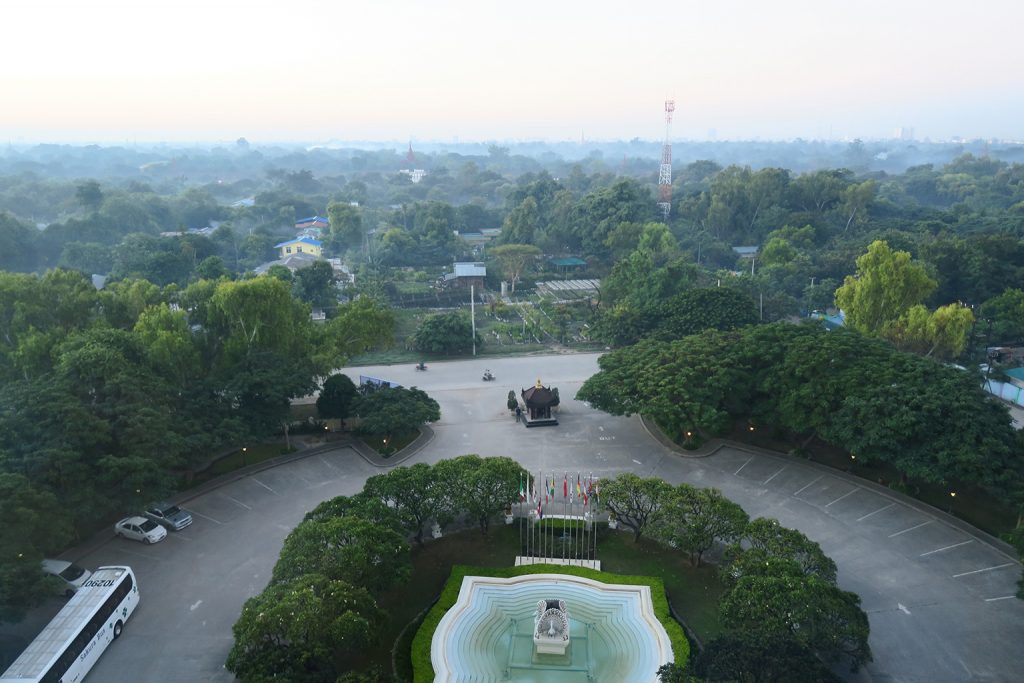
We got up extra early Friday morning and FaceTimed the family back in Brooklyn, who were just finishing their Thanksgiving dinner. The rest of the day was taken up with touring: • The handicrafts area, starting with the huge jade market, then silk weaving, gold-leaf making, then wood and marble carving. More on that later. • The wooden temple of Shwenandaw Monastery — truly magnificent. • Kathodaw, a temple of temples housing the world’s largest book, covering several acres of little temples, each with a large marble tablet inside, inscribed with the words of Buddha — all three volumes. Blew me away!
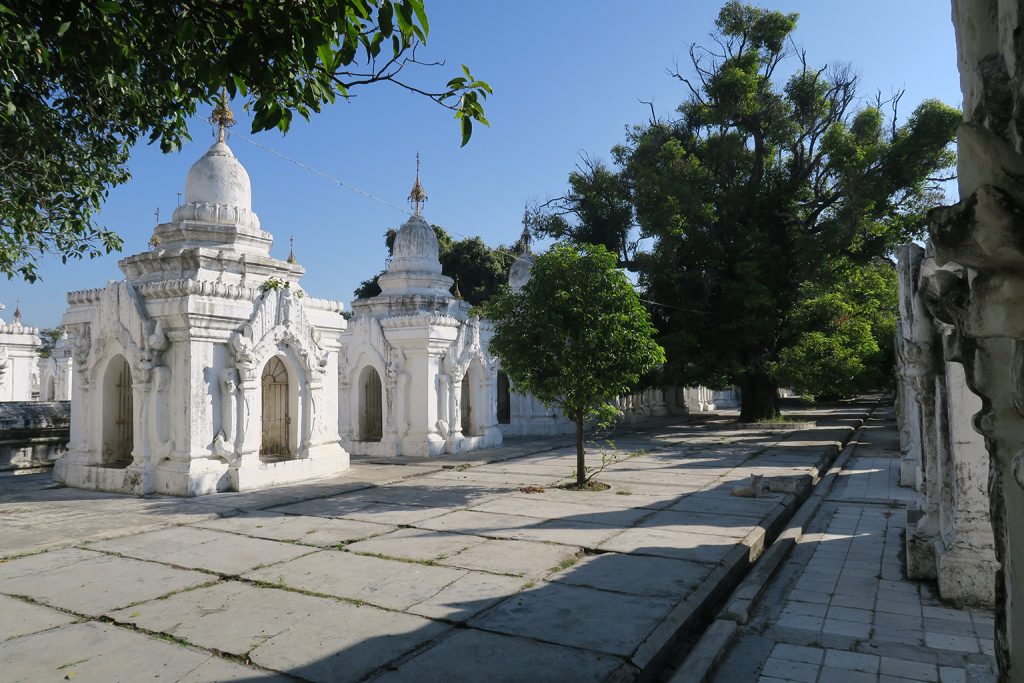
We had a traditional Burmese lunch. Delicious. You order a main dish, say chicken with potatoes, and they bring to the table a huge bowl of Uncle Ben’s style rice and a table full of side dishes, including some small dishes of spicy sauce. You can’t possibly finish it all, and Yu Yu says that’s the point of Burmese hospitality. You provide more than enough. (This was the only place we encountered this treatment.)
Friday afternoon we visited the island town of Ava. There is an amazing teakwood monastery on Ava. It was also once a capital city, but now poor as can be. We were driven around to the see the sights in a horse cart, one of many, and I came to understand that the pollution we get from cars must have seemed like a breeze of fresh air, in their early days.
Then on to Amarapura, yet another former capital, and home to U Bein’s Bridge. The longest wooden bridge in the world, it was one of the items on my bucket list. We walked on the bridge to a central point, where it crossed an island. there we caught a boat and floated around to get good shots of the bridge and of the sunset.

Saturday, November 26. Now we’ve been in Asia for three weeks. I’m surprised. I usually am yearning for home by now, but I’m eager to get on to Bagan.
The flight there is short, but we request more legroom at check-in, and I make sure I’m the first on the plane. The plane boards from the back, and we take the first row, also an exit row on this small plane. So we’re the last ones off. We had legroom!
Bagan
We’re met by a Mr. Han. Stuffy at first, but he loosens up after a while. Bagan, which is located at a strategic point for trade on the Ayeyarwady River. During the 11th through 13th centuries it was a big, prosperous commercial hub. People lived in wood and bamboo structures, but built many (3,200 by Mr. Han’s count) white plaster-covered brick temples. The plaster is almost all gone, so what you see is square miles of big and little brick buildings.

We’re too early to get a room at the hotel, so we tour a few temples, including one they think might be Hindu instead of Buddhist. We take a nap at the hotel and then meet Mr. Han at 4:45 pm for a view of the sunset from a hill he knows. The weather is beautiful, clear and pleasant. At this time of year there is green all around us: trees, sesame, chickpeas, sorghum. In the distance we see a big temple with a flat top. That’s where the big buses go to take tourists to see the sunset. We’re much happier with Mr. Han’s choice, but I have to say that the sunset from our riverside hotel is quite nice, as well.
For dinner we have Mr. H. drop us off at the Star beam, near the Ananda Pagoda. Really good, inexpensive. The cab to our hotel costs us less than $5 in Kyats.
The Balloon Ride
This was another highlight of the trip, expensive but not to be missed! Mary started out kind of apprehensive, but soon got into it. Perfect weather, great views, lovely sunrise, and we had nice people to talk to, and champagne at the end. Here’s just one of over 700 photos:
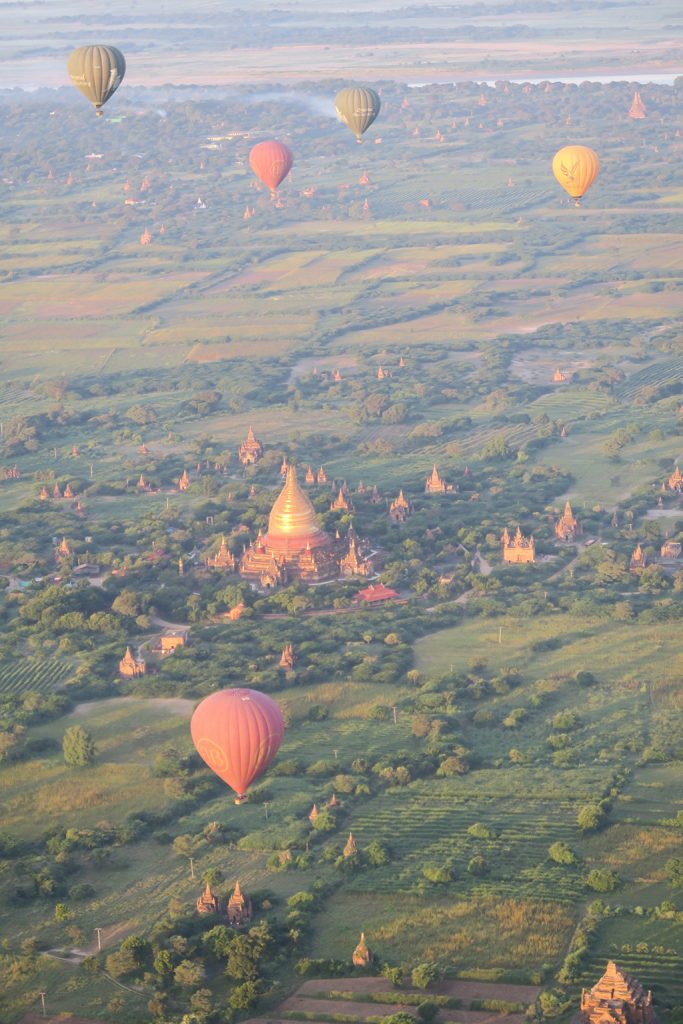
Back to the hotel for breakfast, then off with Mr. H. to Mt. Popa. Stopped at a tourist trap — Mary really likes the local tamarind/palm sugar candy. Further up the slope we got out and hiked a bit through some really lovely scenery to a tiny village. Speaking of balloons, Mr. H. brought along a big bag of them for us to give to the kids. What a hit! Much better than candy, Mr. H. says, and I have to agree. The kids blow them up and use them as noise makers.
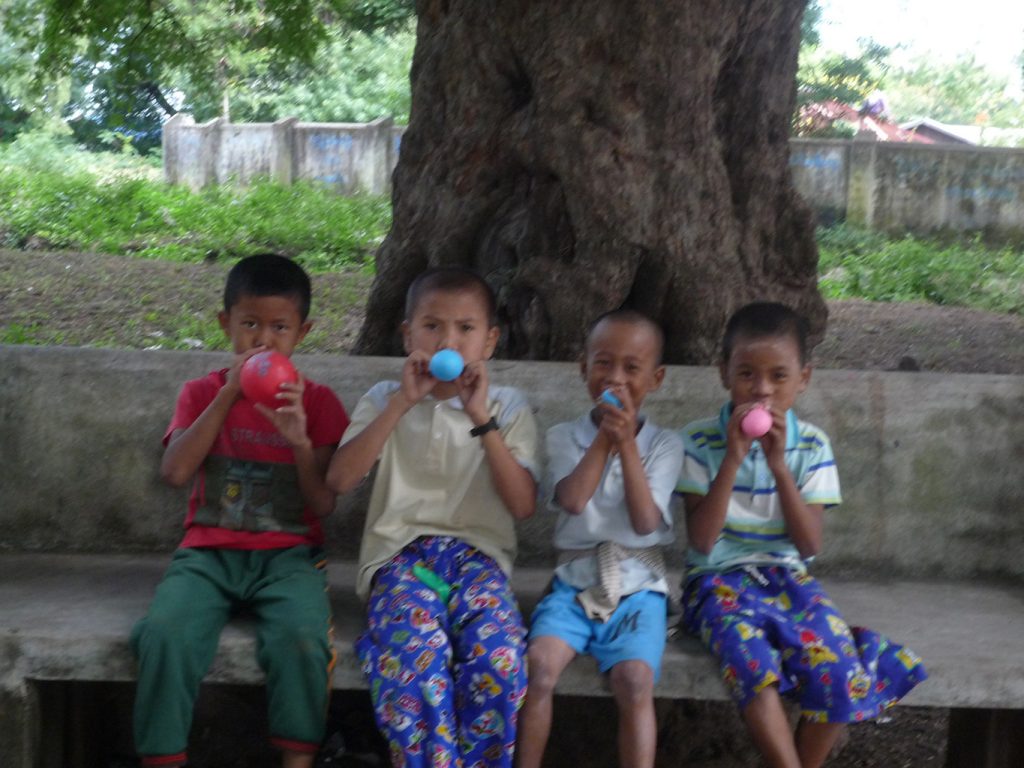
Mary saw a kid with a fixable facial deformity that would only get worse if untreated. It touched her heart, and she offered to help. The parents weren’t around. They were working in the fields. Mr. Han said he would try to get in touch with them, then reach out to us to see if we could provide money for the kid’s treatment. Mary says it will probably take three surgeries, spaced out over some years, to avoid damaging his hearing and sight.
On the far side of town we caught the car. On the way down the mountain we stopped to see what I call ‘Mad Ludwig’s Monastery’ because it reminds me of his Bavarian castle. It’s all glitter and glitz, perched on the very top of a pinnacle.
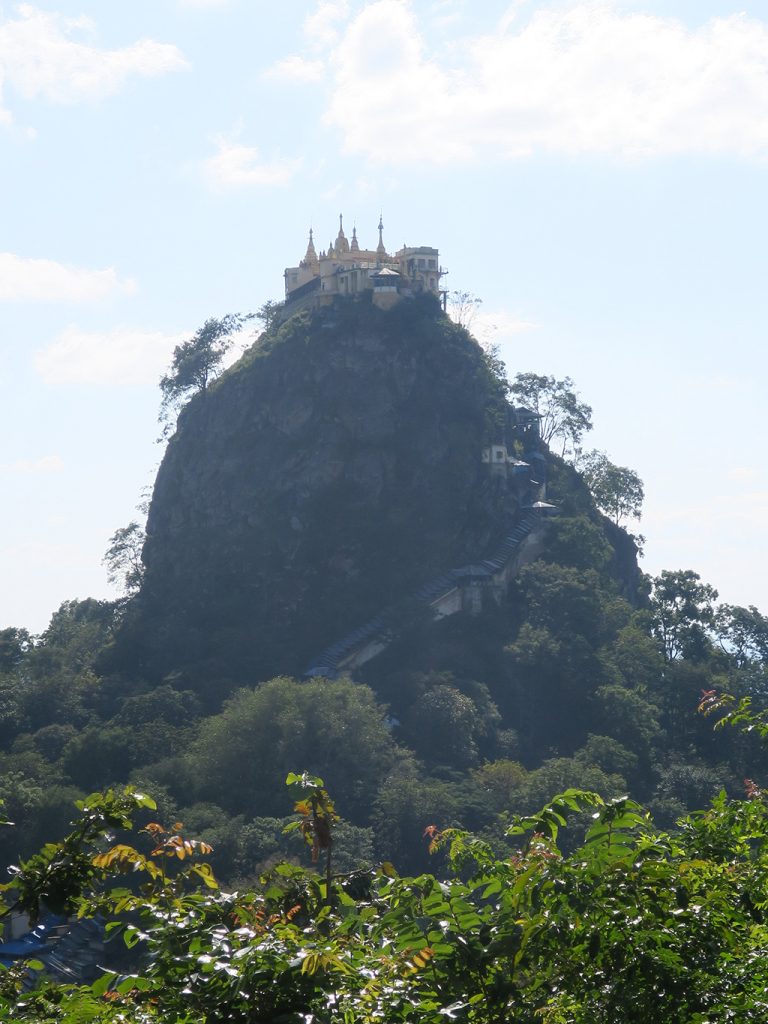
We also stop at a temple — more like a roadside shop — dedicated to ‘Nats.’ There are two 6-foot tall, painted tiger statues at the entrance, and floor-to-ceiling windows along the front, so we don’t have to go in to see inside. There are a few women sitting in the middle of the floor. All along the back are a large variety of statues, and at one end there is an altar of sorts, with offerings and various pictures and statues, which reminded me of nothing more than pictures I’ve seen of private santeria or voudon altars. Nats, according to Mr. H., are old-time deities, actually souls of people who died in horrible circumstance. They are mean, and can cause bad luck, so people here still do things to appease them, even though the practice of nat worship was outlawed centuries ago.
Back in Bagan we visit a laquer-ware shop and then another sight not to be missed (‘You haven’t been to Bagan if you haven’t seen . . .’) the Ananda Temple, from the 11th Century. I think it’s great; Mary is ‘pagoda’d out,’ so we go tee-shirt shopping. I get a nice dark blue one.
Back to the hotel to relax, ending with drinks at the bar.
Monday, November 27, a welcome day of relaxation.
Audley’s done nothing less than a sensational job in organizing this trip for us. But, like other tour operators, they pack their agendas to the brim. I bumped into some people in the business today, and they agree: tour operators want to show you good value for the money. As a result, though, after three weeks of this, a person is exhausted. So today I took a swim, and now I’m catching up on the blog. Tomorrow we head for Inle Lake, where I’m expecting not to have a good internet connection. Ah, having no agenda for a whole day. A vacation from our trip of a lifetime.
Tomorrow, Inle Lake, where there is basically no Internet
CORRECTION: I misspelled ‘Nats’ in the earlier version.
